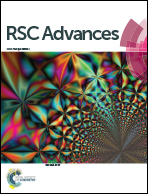Insight into the capacity fading of layered lithium-rich oxides and its suppression via a film-forming electrolyte additive†
Abstract
The capacity fading of layered lithium-rich oxide (Li1.2Mn0.54Ni0.13Co0.13O2, LLO) cathodes greatly hinders their practical application in next generation lithium ion batteries. It has been demonstrated in this work that the slow capacity fading of a LLO/Li cell within 120 cycles is mainly caused by electrolyte oxidation and LLO phase transformation with Ni dissolution. After 120 cycles, the dissolution of Mn becomes worse than that of Ni, leading to structural destruction of the generated spinel phase structure of LLO and fast capacity fading. Tripropyl borate (TPB) is proposed as a film-forming electrolyte additive, which shows a great capability to enhance the cycling stability of LLO/Li, with a capacity retention improvement from 21% to 78% after 250 cycles at 0.5C. Electrochemical and physical characterization demonstrated that the TPB-derived SEI film shows great capability to suppress electrolyte oxidation and the structural destruction of the generated spinel phase of LLO.



 Please wait while we load your content...
Please wait while we load your content...